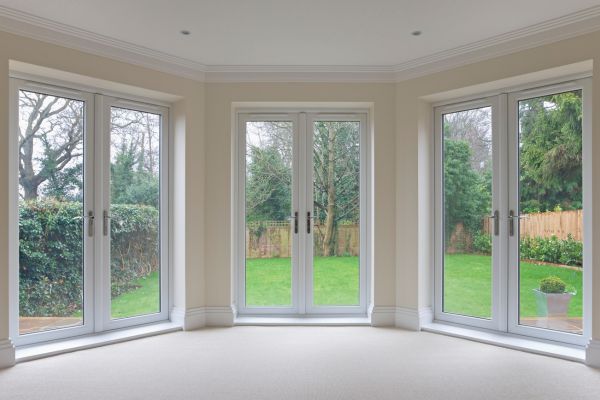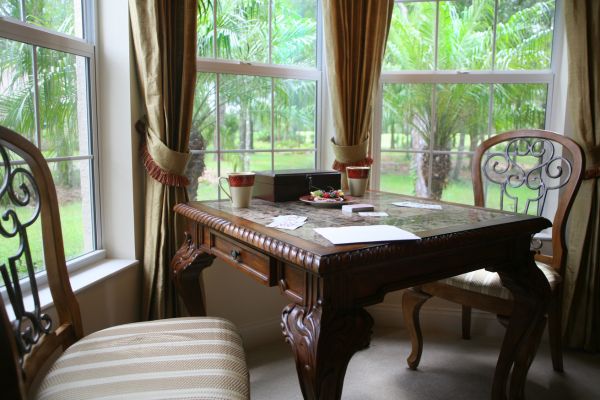Have you been looking for a way to increase your home’s natural light or create more airflow? Do you want to find a solution that adds additional living space, increases your home’s value and boosts curb appeal? If you answered yes to all those questions, bay windows are the solution you’ve been looking for.
Bay windows are a unique configuration that’s been beloved for centuries for their charm and coziness. You’ve likely admired these windows before, but you might not have known their name. If you’re debating adding this unique setup to one of your home’s rooms, you may have questions. Below, we provide the answers to all those most pressing queries!
But before we dive into our helpful homeowner’s guide, check out the bay windows available from Your Window Solutions by clicking the button below. We customize all our windows, so you’re guaranteed a perfect fit – and for the result to be exactly what you’d imagined.
What is a Bay Window?
Bay windows are a unique configuration featuring three outwardly arcing panels that jut beyond the rest of your home’s exterior. Since they extend outwards, these windows also slightly increase your home’s interior living space while creating architectural interest on the outside.
There are many configurations you can choose for your bay windows. However, the most common option is to have a picture window in the middle with operable windows to either side. This configuration is so standard because it perfectly serves several purposes. Picture windows are immovable but provide much more natural light than operable options. The operable windows to either side increase airflow significantly in the room you add them to.
What Configurations Could I Choose?
Although a picture window with operable windows to either side is the most common configuration, it’s far from the only one. You have numerous choices when choosing your configuration, and opting for something less common can create a more interesting visual space.
Consider a full-sized glass door for the center panel to add additional functionality. A picture window here offers lots of extra light, but a larger operable window can further improve ventilation.
For the side panels, double-hung and casement windows are excellent options. Double-hung windows allow you to open the top or bottom section to best catch a breeze. A casement window lets you open the entire panel with an easy-to-use crank mechanism. But you could change things up and opt for unique shape windows like large circles, slim floor-to-ceiling rectangles or tall ovals.
Why Should I Choose Bay Windows for My Home?
There are many reasons to choose bay windows for your home. A few of the most significant include:
- Add architectural interest to your home’s exterior
- Slightly increase your home’s interior living space
- Improve airflow by capturing breezes from two distinct directions
- Let in more natural sunlight (which is great for your mental health!)
- Boost curb appeal
- Increase your home’s value
- Make you more comfortable in your home
If you choose professional installation by reliable window contractors, you’ll also reap many general benefits of new windows. For example, you might experience lower energy costs, better temperature regulation and improved home security.
What Are the Different Types of Bay Windows?
Although bay windows will always consist of three outwardly angling panels, there are several ways to customize them. For example, you can choose one of four unique types of bay windows (discussed here) or one of a few distinctive styles (discussed below).

Canted
These are the most classic bay window shapes and the ones you likely bring to mind when picturing them. A flat front with angled sides defines canted bay windows, only found on the first floor of homes.
Box
Box bay windows are structurally the same as their canted counterparts. The only difference is the shape created by the three panels. Instead of a more angled design, the side panels meet the center at a 90-degree angle to make a box design.
Oriel
This type was first popularized during the English Renaissance. It is unique in that it is built into the side of the home but never touches the ground. For this reason, it can be used on upper floors and isn’t seen exclusively on the ground level. Structural support is often provided by decorative brackets or masonry beneath the windows.
Circle
These are the least common options but are incredibly distinct due to their intricate moldings and ornamental details. Circle bay windows have larger panes of glass to either side and additional panes above the standard three window panes. For this reason, they’re an excellent choice if you’re looking for a lot of natural light.
What Are the Different Styles of Bay Windows?
The types and styles of bay windows are somewhat linked but different enough to deserve their own categories. Window types refer to the window alone, while style refers to a specific aesthetic and architectural design.
The most common styles featuring bay windows include:
- Victorian: Classic canted windows are a defining element of these homes and will often have additional intricate details to enhance their uniqueness.
- Tudor: Small oriel windows may be seen on one or multiple levels, usually with casement windows.
- Modern: Small frames with large glass expanses and clean, unadorned grills offer a sleek design.
- Mid-Century Modern: Clean, minimalistic lines embody this style, often utilizing a traditional central picture window with operable windows to either side.
- Craftsman: Most often used as a functional space, with built-in seating or a decorative ledge built into the bay window’s interior space.
What Does Bay Window Installation Look Like?
Bay window installation is a lengthy, complicated process. It can also look different from one project to another, which is why we provide custom solutions to every job. However, we’ve outlined the basic steps most jobs will include in the sections below.
Prep
The prep for installing a bay window usually goes like this:
- Measure the window opening, taking into account the size, depth and shape you’re hoping for in your new bay window configuration
- Remove the old window and frame
- Detach the windowsill
- Cut and frame the opening (if installing a brand new window), being careful not to knock down any load-bearing beams and avoiding damage to your home’s exterior features
Installation
Installing these windows often looks like this:
- Remove any shingles or siding where you plan to install your cable clamps
- Install your cable clamps
- Level the frame
- Add flashing
- Hoist the bay window into place with the help of at least one to three other people for safety
- Line up the edges of the window at the top and bottom from the inside of your home
- Double check the window is level and resting inside its frame
- Drill screws into the interior frame
- Slide support cables into the cable clamps installed earlier
- Secure your shims
- Attach the roof cab
- Install roofing paper and flashing
- Secure your shingles
- Add step flashing along the corners and edges of the roof cab
- Insulate the window’s bottom with blanket insulation
- Seal window gaps
- Secure your sill and trim pieces
Post-Installation
After the window is installed and securely sealed, you’ll usually need to:
- Carefully clean up any installation mess made at the project site
- Dispose of any debris (large pieces of wood may not be picked up by local trash and will need to be taken to a nearby dump)
- You may need to prime, paint or lay new flooring where you’ve added the bay window in some instances
What Does Bay Window Replacement Look Like?
Bay window replacement looks similar to the installation process detailed above, except it’s simpler. Usually, you only need to replace the window panes rather than create additional space.
Why Should I Hire a Professional to Install or Replace My Bay Window?
Installing or replacing bay windows is a long, challenging process. While it’s true that hiring a professional will cost you a larger upfront investment, it’ll save you in many other ways.
For example, a team of professional contractors can often complete a standard bay window project in a single day. But most DIY projects take two to three days minimum – and that’s if nothing goes wrong.
Most importantly, improperly installed bay windows can lead to higher utility bills, costing you additional money every month. Water damage is also possible, which is costly and can harm your family’s health.
If a window isn’t installed correctly, it can collapse. This poses a safety hazard to your family, pets and anyone nearby when the accident happens. You’ll also be out the costs of your windows and may even find damage down to the new wall or roof where the bay was created.
Long story short, spending the extra money on reliable window contractors is well worth it in the short and long term.
How Far Do Bay Windows Stick Out?
The distance bay windows stick out can vary significantly based on your project’s unique specifications. However, most configurations will stick out between 13 and 19 inches from the rest of your wall.
How Long Do Bay Windows Last?
If you choose high-quality windows and professional installation from a reliable contractor, bay windows should last between 20 and 25 years without issue.
How Much Is Bay Window Replacement Cost?
The cost of bay windows varies significantly nationwide. For an accurate cost estimate, contact us for a free, no-risk consultation.
Do I Need a Permit for Bay Windows?
In most cases, replacing bay windows doesn’t require a permit, but it may be required in some instances. For example, many historic districts and communities may have restrictions on building these, especially in front of your home. If you’re unsure about the laws where you live, call your local municipality or homeowner’s association for more information.

What Can I Do with the Extra Interior Space Created by Bay Windows?
There are countless ideas for what you might do with the extra interior space created by bay windows. Just because the space is relatively small doesn’t mean you can’t do a lot with it! A few ideas include:
- Create a spacious built-in seat
- Design built-in shelving to run along the bottoms of your three panels
- Create a storage bench in the style of old hope chests to eradicate clutter
- Two armchairs, an end table and a rug make a cozy conversation nook
- Turn the space into a puzzle corner with a thing table and a chair (or two)
- Set up a small play area for children that’s out of the way and easy to keep clean
- Use as a well-lit and bright writing area with a writing desk and chair
- Create a lounge area with bean bags and a thickly piled rug
- Use as the perfect place to do your morning yoga
- Use tables or built-in shelving to create a plant area
- Create a breakfast nook for delicious morning meals in the morning light
As you can see, the options are endless! Use your imagination to create a space that best suits your needs and aesthetic preferences.
Looking for High-Quality Bay Window Installation near Lake in the Hills, IL?
Now that you have all the information you need about bay windows, you’re ready to start your project! If you’re looking for high-quality window installation near Lake in the Hills, IL, and the surrounding Chicagoland region, Your Window Solutions is here to help! We’ve been designing and installing custom windows for years, and we’d love to help you with yours next!





